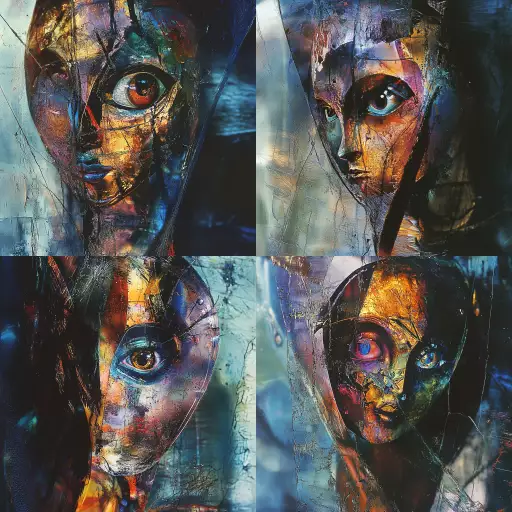Explore the Best AI Image Gallery

Beyond the Canvas: How IoT is Reshaping the Creative Industry
The convergence of the Internet of Things (IoT) and the creative industries is ushering in a new era of innovation. From smart homes that inspire artistic expression to wearable technology that extends our senses, IoT is blurring the lines between the physical and digital realms, empowering creators with unprecedented tools and possibilities.
A Symphony of Connected Devices: IoT Applications in Creativity
The applications of IoT in the creative industry are as diverse as the artists themselves. Here are just a few examples:
- Smart Environments for Immersive Experiences: Imagine an art gallery where installations respond to your movements and emotions, or a theater where the set design dynamically adapts to the narrative. IoT sensors embedded in walls, floors, and objects can collect data about audience interaction, lighting conditions, and even temperature, allowing artists to create truly interactive and immersive experiences.
- Wearable Tech as an Artistic Medium: Fitness trackers, smart glasses, and haptic suits are transforming the way we experience and create art. Wearables can translate physiological data like heart rate and movement into visual or auditory expressions, giving rise to a new form of bio-art. Artists can also use augmented reality (AR) overlays on their wearable devices to interact with digital elements superimposed on the physical world, enriching their creative process.
- Data-Driven Creativity: IoT sensors collect vast amounts of data about our environment and behavior. This data can be analyzed and visualized to inspire new artistic concepts or inform design decisions. For example, a sculptor could use data on wind patterns to create a kinetic sculpture that responds to the elements, or a musician could analyze crowd noise to compose a piece that reflects the energy of the audience.
- Collaborative Creation in Real-Time: IoT enables artists to collaborate remotely in real time. Imagine a team of musicians scattered across continents jamming together through interconnected instruments, or designers sharing and refining 3D models instantly. This global connectivity fosters cross-cultural exchange and accelerates the creative process.
Navigating the Ethical Landscape: Considerations for IoT in Creativity
As with any powerful technology, the integration of IoT into the creative industry raises important ethical considerations:
- Data Privacy and Security: IoT devices collect sensitive data about users. It is crucial to ensure that this data is handled responsibly, with transparent consent mechanisms and robust security measures in place to protect against breaches.
- Algorithmic Bias and Fairness: AI algorithms used in creative applications can inherit biases from the data they are trained on, potentially leading to unfair or discriminatory outcomes. It is essential to develop ethical guidelines and auditing processes to mitigate bias and promote inclusivity.
- Ownership and Intellectual Property: The use of AI-powered tools raises questions about authorship and intellectual property rights. Clear legal frameworks are needed to define ownership and attribution in creative works generated with the help of IoT technologies.
Looking Ahead: Future Trends Shaping the Intersection of IoT and Creativity
The future of IoT in the creative industry is brimming with possibilities:
- Hyper-Personalization: Imagine art exhibitions tailored to your individual preferences, or music compositions generated based on your emotional state. AI-powered personalization will create truly unique and engaging experiences.
- Democratization of Creativity: IoT tools will empower individuals with limited technical skills to express themselves creatively. DIY art projects and accessible design platforms will foster a more inclusive creative landscape.
- Blurring Boundaries Between Physical and Digital Worlds: Augmented reality (AR) and virtual reality (VR) experiences powered by IoT will further enhance our ability to interact with and create digital content in immersive ways.
The convergence of IoT and the creative industries is a transformative journey, unlocking new forms of artistic expression, fostering collaboration, and blurring the lines between the physical and digital realms. As we navigate this evolving landscape, it is crucial to embrace ethical considerations and ensure that technology empowers creativity for the benefit of all.
















](https://images.ai-img.art/thumbnails/150/bddf3ae4a232290858389b933c866ad3be429ef2e25c23a9f4d7713ed6e44d0b.webp)

](https://images.ai-img.art/thumbnails/150/c2c9c48b38fae37f0a457b80b084ed01ba803810fc8f488c8f610c03abc74049.webp)





](https://images.ai-img.art/thumbnails/150/4289d1230b86a96c4d556636c3167bed0ef38f850826549517e4e45db4d87bf7.webp)









](https://images.ai-img.art/thumbnails/150/f9584153b4cddd8c9fab611dc10247549b275c59bc173251e37d0935874f9deb.webp)

](https://images.ai-img.art/thumbnails/150/f67d9af3398150f2ab1bcf250717fea134275e2ca896252b54a4d9bb3719f9ac.webp)


](https://images.ai-img.art/thumbnails/150/008b5d5d49667cc2e93a5f8a8adfaa545963da99c39ff0901f5296294636400d.webp)

